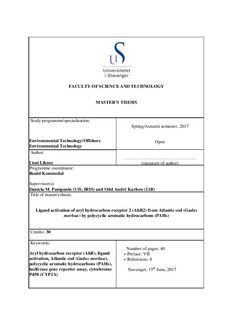Ligand activation of aryl hydrocarbon receptor 2 (AhR2) from Atlantic cod (Gadus morhua) by polycyclic aromatic hydrocarbons (PAHs)
Master thesis
Permanent lenke
http://hdl.handle.net/11250/2458363Utgivelsesdato
2017-06Metadata
Vis full innførselSamlinger
Sammendrag
Petroleum products are the major and most widespread class of contaminants in the marine environment. Anthropogenic sources are heavy contributors, like discharges of industrial and urban effluents, shipping, offshore oil drilling, oil refineries and accidental oil spills. Polycyclic aromatic hydrocarbons (PAHs) and their metabolites are among the most toxic components of petroleum products, and are a cause of great concern in the marine environment, due to their toxicity and persistence in sediments. PAH compounds represents a high risk to aquatic organisms, and ultimately to humans through fish and shellfish consumption and have been regarded as high priority for environmental pollution monitoring.
Cytochrome P450 (CYP1A) is an important enzyme in the biotransformation of PAHs, and is highly induced by the activation of the aryl hydrocarbon receptor (AhR). The metabolism of PAHs by CYP1A often causes an increase in toxicity, as reactive metabolites with the ability to cause crucial cellular damage are produced. Information about bioavailability of PAHs and biological responses is essential in order to assess the risk these contaminants pose to the environment and to advice adequate strategies for protection of biological resources, including those for human consumption.
The Atlantic cod (Gadus morhua) is an economically and ecologically important teleost species. Its genome was recently sequenced and annotated, making it an attractive model for analyzing the effects of environmental contaminants in the marine environment. The widespread distribution of Atlantic cod in the North Atlantic Ocean makes this species vulnerable to effluents from human activities.
Luciferase reporter gene assays, like the UAS/GAL4-based system used in this thesis, is a common in vitro method used to study ligand activation of transcription factors, such as AhR. Seven PAHs were selected to see if they could bind to and activate the cod AhR2. These PAHs were unsubstituted chrysene, along with its alkylated compounds 1-, 2-, 3- and 6-methylchrysene and (1R,2R)-1,2-dihydrophenatrene-1,2-diol and (1R,2R)-1,2-dihydronaphtalene-1,2-diol, which are the trans-dihydrodiols of phenanthrene and naphthalene respectively. Alkylated PAH derivatives exist in various forms, and these alkylated forms have been reported to be more toxic than their unsubstituted congeners. Trans-dihydrodiols are the major PAH oxidation products formed and excreted to bile in fish.
All ligands chosen proved to be able to activate cod AhR2 in vitro, especially the alkylated and oxidized PAHs, making them plausible to cause adverse effects in the marine environment.
Beskrivelse
Master's thesis in Environmental technology
